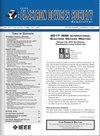Improving the Manufacturability of Low-Temperature GaN Ohmic Contact by Blocking the Fluorine Ion Injection
IF 2
3区 工程技术
Q3 ENGINEERING, ELECTRICAL & ELECTRONIC
引用次数: 0
Abstract
Stabilizing the CMOS-compatible low-temperature Au-free GaN Ohmic contact is a critical work that determines the performance and yield of GaN power HEMTs in mass production. The instability of this contact has been puzzling the industry and academia for years. In this work, an overlooked factor, fluorine injection, is unambiguously verified to widely exist during dielectric etching and can easily destroy the low-temperature GaN Ohmic contact formation. The injection depth is confirmed to be over 30 nm with a fluorine peak concentration of 1023 at/cm3 in vicinity of the surface. Traditional method of partial AlGaN recessing with a pretty tiny processing window is proven unfriendly for production and vulnerable to the fluorine injection. Two methods to get rid of the fluorine are proposed. The first one is to over-etch the AlGaN barrier to the GaN channel to fully remove the fluorine ions. The second is to deposit an etch-stop blocking layer of Al2O3, which is also compatible with CMOS process.通过阻断氟离子注入提高低温氮化镓欧姆触点的可制造性
稳定与 CMOS 兼容的低温无金氮化镓欧姆触点是一项至关重要的工作,它决定着大规模生产中氮化镓功率 HEMT 的性能和产量。多年来,这种接触的不稳定性一直困扰着业界和学术界。在这项工作中,一个被忽视的因素--氟注入--被明确证实在介电刻蚀过程中广泛存在,并能轻易破坏低温氮化镓欧姆接触的形成。经证实,注入深度超过 30 nm,表面附近的氟峰值浓度为 1023 at/cm3。传统的氮化镓部分凹陷方法加工窗口非常小,对生产不友好,而且容易受到氟注入的影响。我们提出了两种去除氟的方法。第一种是在氮化镓沟道上过度蚀刻氮化镓势垒,以完全去除氟离子。第二种方法是沉积 Al2O3 蚀刻阻挡层,这也与 CMOS 工艺兼容。
本文章由计算机程序翻译,如有差异,请以英文原文为准。
求助全文
约1分钟内获得全文
求助全文
来源期刊

IEEE Journal of the Electron Devices Society
Biochemistry, Genetics and Molecular Biology-Biotechnology
CiteScore
5.20
自引率
4.30%
发文量
124
审稿时长
9 weeks
期刊介绍:
The IEEE Journal of the Electron Devices Society (J-EDS) is an open-access, fully electronic scientific journal publishing papers ranging from fundamental to applied research that are scientifically rigorous and relevant to electron devices. The J-EDS publishes original and significant contributions relating to the theory, modelling, design, performance, and reliability of electron and ion integrated circuit devices and interconnects, involving insulators, metals, organic materials, micro-plasmas, semiconductors, quantum-effect structures, vacuum devices, and emerging materials with applications in bioelectronics, biomedical electronics, computation, communications, displays, microelectromechanics, imaging, micro-actuators, nanodevices, optoelectronics, photovoltaics, power IC''s, and micro-sensors. Tutorial and review papers on these subjects are, also, published. And, occasionally special issues with a collection of papers on particular areas in more depth and breadth are, also, published. J-EDS publishes all papers that are judged to be technically valid and original.
 求助内容:
求助内容: 应助结果提醒方式:
应助结果提醒方式:


